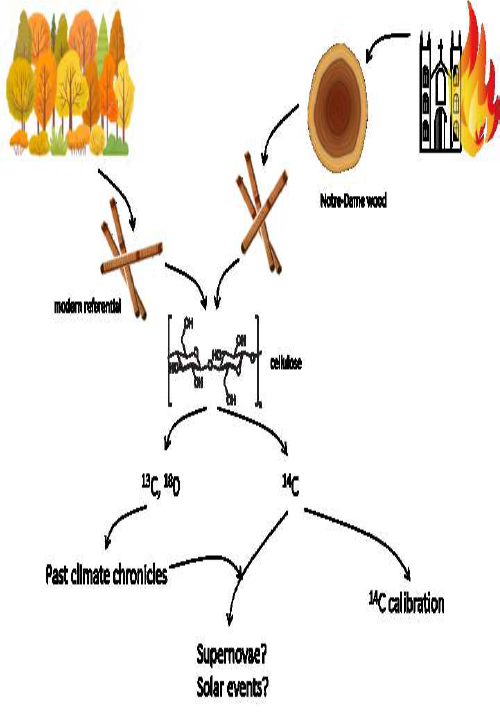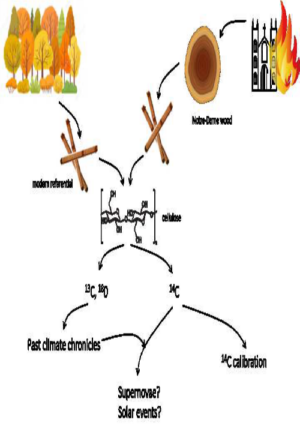Notre-Dame de Paris, la si célèbre cathédrale catholique qui se dresse sur l’île de la Cité à Paris, a été construite en 1163, achevée en grande partie en 1260, puis fréquemment modifiée au cours des siècles suivants jusqu’à une restauration majeure entre 1844 et 1864. Toutes ces étapes de construction et de modifications ont concerné la charpente, appelée « la forêt ». Ainsi, les bois utilisés tout au long de l’histoire de la cathédrale sont des échantillons et des souvenirs des forêts de chênes cultivées dans le Bassin parisien depuis le Moyen Âge. La destruction malheureuse de la cathédrale le 15 avril 2019, qui a miraculeusement épargné une partie de la charpente, a rendu ces bois accessibles à la communauté scientifique. Certains scientifiques s’intéressent particulièrement à la composition isotopique du bois comme mémoire du climat passé et comme horloge du passé. D’une part, les isotopes de l’oxygène et du carbone (d13C et d18O) de la cellulose des cernes d’arbres permettront de faire la lumière sur le climat passé. En effet, la composition isotopique de ce composant est déterminée par les conditions entourant les arbres pendant leur croissance. Les variations de d13C et d18O dans le temps, enregistrées dans les cernes successifs construits par les arbres année après année, permettent de reconstituer l’évolution de certains paramètres environnementaux ou climatiques tels que la température ou l’humidité. La dendroclimatologie isotopique, un domaine d’investigation en pleine expansion, est appliquée aux vieux arbres vivants, aux bois subfossiles des bâtiments ou même aux matériaux fossiles pour reconstruire le climat passé. Cette approche méthodologique sera appliquée aux bois de chêne de la cathédrale qui ont échappé à une carbonisation importante et aux bois contemporains non brûlés provenant d’autres bâtiments (figure 1). D’autre part, la mesure anneau par anneau de la teneur résiduelle en isotope 14C dans la cellulose permettra d’affiner l’horloge 14C qui permet de dater tout matériau contenant du carbone. Ceci sera réalisé en fournissant de nouvelles portions de la courbe d’étalonnage globale pour l’Europe occidentale continentale du 12e au 18e siècle, à partir de la « forêt » non carbonisée de Notre-Dame.
Daux V., Hatté C., duBoisgueheneuc D., Beck L., Richardin P. The ‘forest’ of Notre dame de Paris: a path into medieval climate and time. Journal of Cultural Heritage, In press



